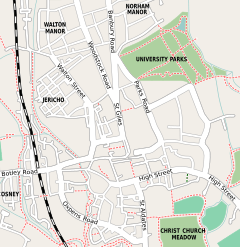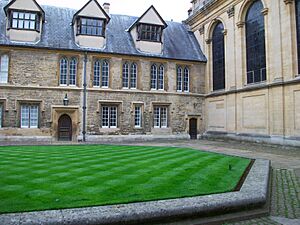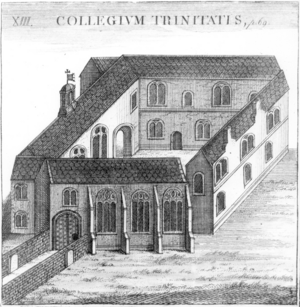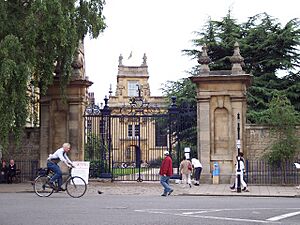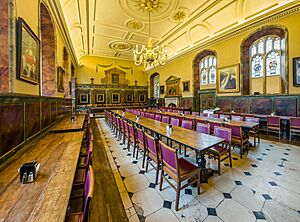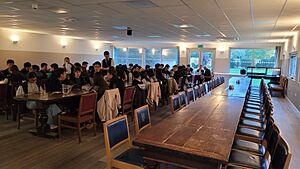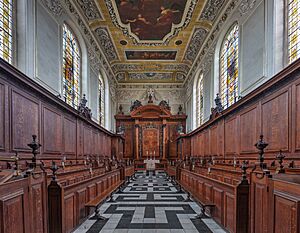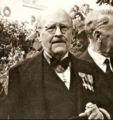Trinity College, Oxford facts for kids
Quick facts for kids Trinity College |
||||||||||||
|---|---|---|---|---|---|---|---|---|---|---|---|---|
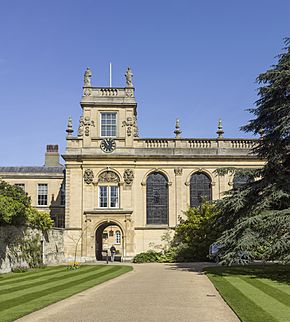 |
||||||||||||
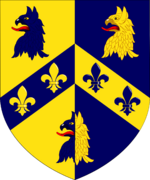
Blazon: Per pale or and azure, on a chevron between three griffins' heads erased four fleurs-de-lis all counter-changed (arms of Sir Thomas Pope, Founder)
|
||||||||||||
|
|
||||||||||||
| University | University of Oxford | |||||||||||
| Location | Broad Street, Oxford OX1 3BH | |||||||||||
| Coordinates | 51°45′19″N 1°15′25″W / 51.755343°N 1.256958°W | |||||||||||
| Full name | The College of the Holy and Undivided Trinity in the University of Oxford, of the foundation of Sir Thomas Pope (Knight) | |||||||||||
| Latin name | Collegium Sanctae et Individuae Trinitatis in Universitate Oxon. ex Fundatione Thomae Pope Militis | |||||||||||
| Motto | Latin: Quod tacitum velis nemini dixeris (That which you wish to be secret, tell to nobody) | |||||||||||
| Established | 1555 | |||||||||||
| Named for | The Holy Trinity | |||||||||||
| Sister college | Churchill College, Cambridge | |||||||||||
| President | Dame Hilary Boulding | |||||||||||
| Undergraduates | 308 (2011/2012) | |||||||||||
| Postgraduates | 125 | |||||||||||
| Boat club | Boat Club | |||||||||||
| Map | ||||||||||||
Trinity College is one of the colleges that make up the University of Oxford in England. Its full name is The College of the Holy and Undivided Trinity in the University of Oxford, of the foundation of Sir Thomas Pope (Knight). Sir Thomas Pope started the college in 1555. It was built on land where Durham College, a place for Benedictine monks from Durham Cathedral, used to be.
Even though Trinity College is a big place, it only has about 400 students. It was first a college only for men. In 1979, it started accepting both men and women. In 2022, Trinity College had about £212 million in funds.
Trinity College has had three students who later became British prime ministers. This puts it third among Oxford colleges for producing prime ministers.
Contents
History of Trinity College
Durham College's Past
The land where Trinity College stands was once home to Durham College. This college was built for Benedictine monks from Durham Cathedral. It was founded after land was bought in 1291. The site was given to the Crown in 1545. Then, in 1553, it went to private owners.
Sir Thomas Pope, a government worker, bought the land in 1555. Just 16 days later, he used it to start Trinity College. Durham College was originally named after the Virgin Mary, St Cuthbert, and the Trinity. It is thought that Trinity College got its name from the "Trinity" part of this old dedication.
Starting Trinity College
Sir Thomas Pope founded Trinity College in 1555. He bought the land after Durham College was closed during the Protestant Reformation. Pope was a Catholic and had no children. He hoped that by starting a college, students would remember him in their prayers. His remains are still near the chapel altar.
The first college had a president, 12 fellows, and 12 scholars. It also had space for up to 20 undergraduate students. The fellows had to become priests and stay unmarried.
Trinity College was only for men until 1979. Then, like many other Oxford colleges, it started to accept women students. Now, both men and women live and study there. Between 2015 and 2017, about 41% of UK students admitted to Trinity came from state schools.
Trinity College has been used as a filming location. Parts of the TV series Brideshead Revisited were filmed there. It also appeared in episodes of Inspector Morse, Lewis, and Endeavour.
Dame Hilary Boulding became the president of Trinity College in August 2017. She used to be the head of the Royal Welsh College of Music and Drama.
Trinity–Balliol Rivalry
For many years, there has been a strong and friendly rivalry between students from Trinity College and its neighbor, Balliol College. This rivalry shows up in sports, rowing races, and even in songs sung between the colleges. Sometimes, students from one college would play pranks on the other.
College stories say the rivalry started in the late 1600s. It's said that Ralph Bathurst, who was president of Trinity, threw stones at Balliol's windows. The first signs of this rivalry were recorded in 1583. But the modern rivalry seems to have started in the late 1890s. This is when a chant called a "Gordouli" began to be sung from the Balliol side. The traditional words are:
Gordouli
Face like a ham,
Bobby Johnson says so
And he should know.
Even though these exact words are rarely heard now, singing songs over the wall is still called "a Gordouli." It's even said that students from both colleges sang the traditional Gordouli in the trenches during World War I.
In the early 1900s, the rivalry became even stronger. Many Balliol students had more modern political ideas. Trinity, on the other hand, was known for being more traditional. The president of Trinity from 1907 to 1938, Herbert Edward Douglas Blakiston, was known for not wanting to admit non-white students. Balliol, however, did accept many students from India and Asia. This sometimes led to unpleasant remarks from the Trinity side.
The author Dorothy L. Sayers mentioned the rivalry in her books. In Five Red Herrings (1931), a character from Balliol says he never knew any Trinity men. In Murder Must Advertise (1933), a Trinity man says, "If there is one thing more repulsive than another it is Balliolity."
One clever prank from Balliol in the 1960s involved covering the whole of Trinity's junior common room with grass and daffodils. In 1985, three Trinity students sent fake letters to new Balliol students. The letters asked for a "sample" for a medical check-up. Balliol later said 57 samples were returned. The students then put up a banner over Balliol that said, "We are Balliol. Please Don't Take The Piss!" The last known incident related to the rivalry was in 2010. Trinity's pond was damaged, and most of its fish died.
College Buildings
The main entrance to Trinity College is on Broad Street. It is between Balliol College and Blackwell's bookshop. It is also across from Turl Street. The college has an iron fence instead of a solid wall. Its blue gates make it look more open than many other Oxford colleges. The back of the college is next to St John's College. It has entrances on both St Giles' and Parks Road. Besides its four main courtyards, the college also has a large lawn and gardens, including a small wooded area.
Durham Quadrangle
Trinity College was built around one main courtyard, now called the Durham Quadrangle. It is named after Durham College, which was on this site before Trinity.
The Chapel
The chapel is not as big as some other Oxford chapels. But it was the first college chapel designed completely in the Baroque style. Henry Aldrich designed it, with advice from Christopher Wren. It was officially opened in 1694.
On top of the west tower, there are four statues of women. They represent Astronomy, Geometry, Medicine, and Theology.
Garden Quadrangle
The north side of this courtyard was designed by Christopher Wren. It was built between 1665 and 1668. The west side was added in 1682, following the same design.
Front Quadrangle
The Front Quadrangle is between the Durham Quadrangle and Broad Street. It was created by new buildings from 1883 to 1885 and the president's house from 1885 to 1887. Both were designed by Thomas Graham Jackson. This area also includes older buildings on Broad Street. These are four old cottages and Kettell Hall, a stone house built around 1620.
Library Quadrangle
The Library Quadrangle is between Jackson's new buildings and the new library. The library was built from 1925 to 1928. It was a memorial to college members who died in World War I. The building was designed by Mr. J. Osborne Smith. The fancy curved roof was made by Leonard Shuffrey.
The Cumberbatch buildings to the north and south were built from 1964 to 1966. The Norrington Room of Blackwells bookshop is located underneath this courtyard. It is named after Arthur Lionel Pugh Norrington, a former president of the college.
In 2018, the college got permission to build a new building. It is north of the library quadrangle and the university's Weston Library. This new building, called the Levine Building, opened in 2022. It is part of a big plan to change Trinity College.
Student Life
Trinity College offers places to live for all its undergraduate students. First and second-year students live on the main college site. Third and fourth-year students live in college buildings on Woodstock Road.
Chapel Choir
The Trinity College Chapel Choir has up to eight students who are choral scholars. It also has over thirty volunteer singers. Most members are from the college itself. The choir sings a weekly Evensong on Sundays. They also sing at special college events. Trinity College does not have a music director. The organ scholars are in charge, and the chaplain oversees them.
The choir goes on tours every year. Recent tours include Dublin in 2008, Rome in 2009, Paris in 2010, Barcelona in 2011, and Vienna in 2012. In 2009, the choir released a CD called 'A Voice from Afar'.
Notable Former Students
Over its more than 400-year history, Trinity College has had many famous students. They have gone on to careers in areas like academics, politics, science, religion, and the arts.
-
St John Henry Newman, a famous religious leader and writer
-
Henry Moseley, a physicist who discovered Moseley's law
-
Sir Jacob Rees-Mogg, a former leader in the British Parliament
-
Sir Richard Burton, a famous explorer and writer
-
Philippe of Belgium, the current King of the Belgians
-
Sir Eric Errington, a Conservative Party politician
Gallery
-
Bust of Cardinal Newman outside Garden Quad
-
From the lawn looking towards Wadham College
See also
 In Spanish: Trinity College (Oxford) para niños
In Spanish: Trinity College (Oxford) para niños


